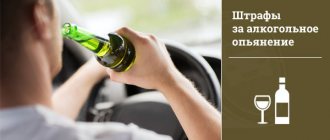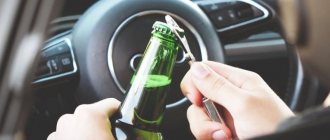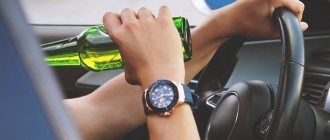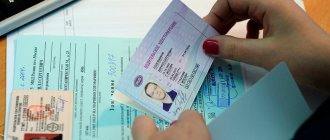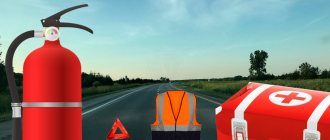Is a medical examination for intoxication after an accident legal?
But let’s talk about everything in order: first, let’s look at the main questions about tests for intoxication, and at the end of the article we will present all the rules of this procedure, since they are very voluminous and meaningful.
So, let's start with the legality of the examination itself. This becomes possible for the executive branch in the form of police officers, thanks to changes that have been made to a number of regulations. These include the Code of Administrative Offenses and the Inspection Rules themselves.
Thus, several years ago, amendments were made to Article 27.12 of the Code of Administrative Offenses, and now its part 1.1 states that a driver in respect of whom a determination has been made under Article 12.24 is subject to referral for examination. But what does some article of the Code of Administrative Offenses have to do with this?
And 12.24 just speaks of the victims. To be more precise, in cases where a driver is suspected of committing a traffic violation or is involved in an accident in which there are injured people, then he is subject to examination. Please note that sending for an examination is not an inspector’s right, but an obligation. That is, the policeman does not decide here, but a simple condition works: are there any victims of the accident? This means that a test for intoxication is mandatory.
A similar requirement is contained in paragraph 2 of the Inspection Rules in Government Decree No. 475.
What to consider during the examination
So, as already mentioned, inspectors are different and may not stop you with good intentions. Therefore, in order not to be deceived, your actions when stopping your car should look something like this:
- after you are stopped, be sure to ask the inspector to show his official document. He is not obliged to give it to you, but must unfold it so that you can read what is written. If he refuses to do this, feel free to call the police and report that the traffic service officer refuses to perform the action provided for by the regulations of the Ministry of Internal Affairs of the Russian Federation;
- even if you drank some beer a couple of days ago or earlier, do not tell the inspector about it. This alcohol no longer counts, but for a dishonest traffic police representative this is another reason to send you for examination and “pressure”;
- you have the right to refuse an examination on the spot, and you can safely demand a medical examination, especially if the policeman confuses you in some way. If he refuses to take you to a medical facility, this is suspicious, you can call the police;
- do not forget that if you agree to a quick examination, witnesses must be present or recorded on video. Check this before carrying out the procedure, and the entire check must be recorded in a special protocol;
- The breathalyzer with which the test will be carried out must issue a receipt with the results and time of the procedure. Modern devices can make several copies, which must be signed by the witnesses present.
What is suspicious:
- absence of witnesses and refusal to film the procedure. As a rule, the inspector finds “understandable” people after the fact, and their signatures are put on the document, accordingly, you find yourself guilty and nothing can be proven;
- if there are no witnesses, and the inspector says that there is no recording device, offer your mobile phone, you can even without an announcement.
The alcohol measuring device must have a stamp on it that allows you to verify that it has passed the test. Also, at your request, the police officer is obliged to provide you with a certificate for it and the original document on its verification.
If these documents are missing, you can use your phone camera to record the violation and contact the police.
Can I refuse a medical examination?
This depends on the type of check, and there can be 2 of them:
- examination for alcohol intoxication (hereinafter referred to as “OSAO”),
- medical examination for intoxication (hereinafter referred to as “MOSO”).
For now, remember these 2 types of tests. They are radically different, although they are closely interrelated. Below we will talk more about their differences.
But the main thing you should know is: you have every right to refuse to be tested for alcohol (“blowing” on the road in the inspector’s car), and you will not face any consequences for this. But if you refuse a medical examination, punishment will follow - and quite severely. And the refusal of CILUMV itself is one of the direct grounds for referral for a medical examination.
Does this threaten deprivation of rights or a fine?
Both. For refusal of a medical examination in 2021, a separate standard of responsibility is provided - Part 1 of Article 12.26, which threatens 2 penalties simultaneously:
- a fine of 30,000 rubles for refusing a medical examination,
- deprivation of rights for a period of 1.5 to 2 years (by decision of the judge).
This punishment is imposed by a court (magistrate) on the basis of a protocol of a traffic police officer, drawn up in accordance with all the rules after the driver has been removed from driving, the involvement of 2 witnesses or the production of a video recording, as well as a preliminary offer to undergo an examination for intoxication. Here is a typical example from judicial practice regarding deprivation for refusal of a medical examination with no less typical arguments for the defense of the accused driver.
Please also note that the penalty for refusal is the same as the penalty if intoxication is properly established. Part 1 of Article 12.8 of the Code of Administrative Offenses of the Russian Federation provides for the same fine and the same period of deprivation of rights for driving while intoxicated (including road accidents while intoxicated).
The only difference is that in case of deprivation for refusal of a medical examination, there cannot be an additional punishment for handing over the steering wheel to a drunk person, since intoxication will not be established legally.
Full range of labor protection, civil defense and emergency services
Enter your phone number and I will calculate an estimate for your tasks. Enter without the eight. “Bureau of Ekaterina Vorontsova” – professional solutions to your problems: with high quality and on time!
Certificate of examination for alcohol intoxication
To obtain a conclusion, mandatory examinations must be carried out:
- Exhaled air intake.
- Examination of urine and saliva.
If the employee being tested is unconscious, then additional blood is taken for analysis.
Test samples are stored in a medical institution for a month under certain conditions, in case any controversial situations arise during this period.
At the time the employee undergoes an examination and draws up an examination report for alcohol intoxication, it is necessary to provide any of the identification documents:
- passport
- driver's license
- any other document confirming your identity.
If it is determined that an employee is drunk at work, it is necessary to remove him from his duties or dismiss him under Article 81 of the Labor Code of the Russian Federation.
The main thing is to make sure that the doctors write down the phrase in the report - is in a state of intoxication (with an explanation of what kind of alcohol, narcotic, toxic).
This is important, since very often employees go to court and try to challenge the eligibility of dismissal, so in this procedure it is necessary to take into account all the subtleties.
And if you read part b of paragraph 6 of Article 81 of the Labor Code of the Russian Federation, then it is clearly written that an employment contract may be terminated if an employee appears at the place of performance of work duties in a state of alcohol, narcotic or other toxic intoxication, therefore this phrase, with legal point of view, correct.
Yes, bureaucracy, but since such conditions have been created, you need to feel confident in them.
You can download a sample report on an employee being intoxicated by clicking on the link.
Sample certificate of examination for alcohol intoxication (1 page)
Sample certificate of examination for alcohol intoxication (page 2)
Video recording of what is happening
I would also like to note that it would be useful to record a video of an employee in an inadequate state, because in my practice there was such a case, the foreman showed up drunk at work and, apparently, brought a “supplement” with him.
At some point in time, he decided that his employees were not sufficiently provided with personal protective equipment and headed to the warehouse, where he showed aggressive behavior in every possible way, and the storekeeper smelled alcohol and tried to calm him down.
As a result, the foreman grabbed a nearby fire extinguisher and discharged it inside the warehouse, hitting a warehouse employee.
There were no other witnesses to this event, but the installed cameras played a decisive role in court when the foreman tried to challenge his dismissal under the article.
Act on violation of labor discipline
In addition to the document from the medical institution, it is necessary to prepare an Act on violation of labor discipline, which will also record the fact that the employee is intoxicated; it is drawn up in any form; there is no prescribed form.
In this document, clearly explain the situation, write down the signs of intoxication, and two or three employees must sign the act. From my own experience I will say that three signatures will be more significant and correct.
If an employee comes to work drunk, prepare violations of labor discipline for your case.
Sample Act on violation of labor discipline
Explanatory notes
In addition, a drunk employee must provide a written explanation of the reason for his appearance at work in a state of alcoholic intoxication.
If an explanation is not provided within two days, draw up an act of refusal of explanation, also tripartite.
Eyewitnesses of what is happening, witnesses, must also prepare detailed explanatory notes, indicating all the circumstances.
You can download a sample report on a drunk employee who did not provide an explanatory note by clicking on the link.
Sample Statement of Refusal to Explanation
Drawing up an order to remove an employee
There is no unified form for an order to remove an employee who was intoxicated, so it is necessary to describe the circumstances in detail, make footnotes to explanatory notes, memos and acts.
Specify the period of suspension and non-accrual of wages for this period of time (Article 76 of the Labor Code of the Russian Federation).
I leave my sample order to suspend an employee from work, you can use it for your situation.
Sample Order to suspend an employee in a state of intoxication
Is this an alcohol or drug test?
Above we indicated that there are 2 types of examination. It is precisely the target verification that distinguishes them.
- CVUIL is carried out directly on the road by “purging” the breathalyzer (sometimes, if the inspector does not have the device with him, then you may be taken to the nearest post). And this check is carried out only for the purpose of establishing alcohol intoxication - exhaled air vapors are examined to determine the percentage of ethyl alcohol in them.
- MOSO is a full-fledged study in a medical institution. Here, too, a breath sample is first taken to analyze the alcohol content. But as an additional procedure - chemical and toxicological studies. They are carried out to determine the content of narcotic drugs in the driver’s body. The collection can be either urine (carried out in all standard cases) or blood (blood is taken only if the driver is unconscious after an accident and, accordingly, will not be able to “give out” urine for testing).
The intoxication test is carried out with the consent of the driver. A medical examination is carried out only if one of 3 grounds is present:
- if the driver refuses to be tested for alcohol,
- if the device shows intoxication during the CIAU, but the driver does not agree with the results of the “breathalyzer”,
- if the breathalyzer shows zero, but the traffic police officer believes that the driver is still drunk (for example, due to drug use).
As you can see, the medical examination in any case should be preceded by a “purge” on the road. If the inspector did not offer you a compulsory insurance but immediately sent you to the MOSO, then this is illegal, since the procedure for collecting evidence was violated. This is exactly what the Supreme Court thinks, which in its Resolution of the Plenum No. 20 (paragraph 11) indicated that this is illegal, except in cases where the driver is unconscious, and it is not possible to “blow out” him on the spot. And in paragraph 23 of the same judicial practice it is stated that evidence obtained in violation of the law is not subject to consideration.
The procedure for conducting a medical examination by a traffic police officer
The administrative regulations of the Ministry of Internal Affairs clearly regulate how the examination should be carried out by a traffic police officer. A traffic police officer is obliged to behave appropriately and, if there is suspicion of alcohol or drugs in the blood, take the following mandatory actions:
- The driver must be suspended from driving the vehicle;
- A protocol is drawn up;
- The citizen is explained the actions that will be applied to him;
- Air is taken from the suspect in the form of exhalation into a breathalyzer;
- Based on the results obtained during the implementation, a report is drawn up;
- All actions are carried out in the presence of two witnesses.
If one of the points is violated, the results of the procedure are invalid.
Is any road accident sent for testing?
In general, they can send it in case of any incident. The 2021 legislation only states that under certain conditions this procedure is mandatory.
Is an examination required if there is an accident without injuries?
No. But this is not excluded. The fact is that the same part 1.1 of Article 27.12 indicates that a person is subject to testing for alcohol or drug intoxication if there are reasonable grounds to believe that he is drunk.
Thus, even if there was an accident without injuries and even if there was no accident, and you were stopped by a traffic police officer and assumed that you were drunk, then he has the right to check you properly for this.
But the inspector’s assumptions must be supported by clearly specified criteria and conditions. All of them are described in paragraph 3 of PPRF No. 475, and they include 5 grounds:
- smell of alcohol from the driver's breath,
- speech disorders,
- unstable posture,
- if your facial skin has changed color dramatically,
- if the behavior does not correspond to the situation.
And here lies almost any opportunity to check the driver for alcohol intoxication. If the first 4 conditions, which are quite clear, do not fit the situation, then the fifth is quite universal. Did you look at the inspector wrong? Stumbled while getting out of the car? These are all reasons to indicate that the behavior is not appropriate for the situation. Moreover, in the protocol the employee is not obliged to specify exactly how your behavior was inconsistent and how it was expressed. Although later in court, when considering the case, the judge may question the employee on this issue.
But in any case, in any situation on the road, even not just after any accident, a traffic police officer has the right to check the driver for intoxication.
If there are any injured and/or dead?
And this is where the main difference from an accident without casualties lies. As we mentioned above, if there is harm to health, examination becomes mandatory. And this does not depend on the inspector's decision.
At the same time, first the employee who arrives at such an accident is obliged to carry out a “purge” in the breathalyzer, and only after the driver refuses it, or disagrees with the results of the driver or the inspector himself, offer to go to a medical facility for a full check. If the latter refuses, the motorist will already face deprivation of rights for a long period and a large fine.
How does the medical examination procedure work?
If for one reason or another you are not satisfied with the results of the examination, you can conduct the study again, but with the participation of medical professionals, who will conduct a more complete examination of your current condition. There are the following grounds for conducting a medical examination, provided for by the law of the Russian Federation:
- if the driver refuses to undergo an alcohol test by a traffic police officer;
- if you disagree with the results of the examination carried out at the site of the transport stop;
- if the device showed negative data for the presence of alcohol, but the traffic police officer has sufficient reason to believe that the driver was drunk or under the influence of drugs;
- if there is a reason to declare an administrative offense against the driver;
- if the driver is suspected of committing an unlawful act aimed at endangering traffic on the road by other participants or related to the use of transport.
If there are certain grounds for repeating the procedure, a protocol is drawn up with two witnesses. The police officer is also obliged to establish the driver’s identity if this was not possible before.
After drawing up the appropriate protocol and signing it by all parties, the driver is sent for a medical examination. If the driver independently refused the on-site examination or did not agree with its data, you should make sure that in this case there are signatures of witnesses. Then the driver, in the presence of the inspector, must proceed to the place of examination.
Medical examination must be carried out in a specialized medical institution that is licensed to provide medical services or in a mobile medical center that meets all the requirements provided by the Ministry of Health and the Ministry of Social Development.
If the results of the examination establish that the driver did not drink alcohol or drugs, then the traffic police officers undertake to take him to the location of the car or to the place where he was suspended from driving and return the vehicle.
The requirements for a medical certificate are:
- it should be carried out in medical institutions or mobile medical units equipped accordingly;
- the examination procedure must be carried out by a doctor who has previously undergone appropriate training at drug treatment institutions according to a program approved by the Ministry of Health. You can verify the availability of the relevant document from the doctor who will perform the procedure.
When the procedure is carried out, the doctor draws up a conclusion about the person’s condition at the time of the procedure. The document is an act that includes one of the following wordings:
- the person’s state of intoxication has been established;
- condition is normal, no alcohol detected.
When determining intoxication, the specialist does not note the substance that caused the intoxication.
It is worth noting that if the traffic inspector wanted to force you to pay a fine, then he is unlikely to agree to a re-examination in the presence of a specialist. But if, after all, you are sober and you are taken for a second examination, then too much time will be spent.
Who should be checked?
Only the driver is subject to referral for examination - and only the driver in respect of whom a determination has been drawn up under Article 12.24 of the Code of Administrative Offenses of the Russian Federation.
But no, and the second driver can be “blown away” in an accident. But for this you will already need your own reasons (sufficient to assume that he is drunk). And only for the alleged culprit of an accident there is only one reason for verification - the presence of victims and, as a consequence, determinations under 12.24 of the Code of Administrative Offenses.
What are the inspection rules for road accidents in 2021?
In general, if there is a suspicion that the driver is drunk, any check should begin with a suspension protocol - this is one of the main rules of this procedure. However, in the event of an accident with victims, the driver is not supposed to be removed from driving the car - there is no such obligation in the Code of Administrative Offenses of the Russian Federation.
However, there are quite voluminous and complex rules, and the procedure for the inspector consists of many points. In general, collecting evidence specifically for drunk driving offenses is one of the most procedurally difficult.
Let's look at the correct order of this procedure one by one.
- The inspector arrives when called to an accident involving injuries. In this case, he must draw up a ruling on an administrative offense, thereby launching an investigation procedure under Article 12.24 of the Code of Administrative Offenses of the Russian Federation, which contains penalties for causing harm to the health of other people. That is, the driver has already violated something (for example, drove through a red traffic light), which caused the accident. But, if there are victims, there will be not only a fine for the prohibitory signal, but also for causing harm to health.
- Article 27.12 provides that if the specified determination is available, the one in respect of whom it is drawn up must undergo an examination procedure.
- Then the traffic police officer suggests that the driver take a breather. In this case, a certified device must be used, it must have a verification certificate, and it must produce the result on paper (clause 5 of the Inspection Rules).
- And before starting the inspection, the employee must tell the driver about the CILUMV procedure, as well as show the integrity of the verifier’s mark and indicate the presence of a verification certificate (paragraph 6).
- Based on the results of the compulsory insurance, an inspection report is drawn up. If the device shows that your exhalation contains 0.16 milligrams per liter of air or more, then the report indicates that a state of intoxication has been established. And a paper printout from the “breathalyzer” is attached to this document (points 7-9).
- If the driver does not agree with the results of the examination for alcohol intoxication, or if the traffic police officer does not agree with them, and also if the driver refuses to undergo this procedure, then the latter is subject to referral for a medical examination (clause 10).
- In this case, an appropriate protocol must be drawn up, which indicates the basis for the MOSO, the place and time of the referral, and the protocol itself is signed by the inspector and the driver (Article 27.12.1 of the Code of Administrative Offenses of the Russian Federation).
- Next, the driver is taken to a medical facility. In very rare cases in 2021 there may be mobile laboratories that can be at the scene of an accident.
- A new legal act is already beginning to take effect here - Order No. 933N on the MOCO Rules. At the facility, a sample of the driver’s air is taken to analyze the alcohol content in the breath. If the exhalation showed 0.16 mg/liter or more, then a second sample is taken 15 minutes apart. By decision of the doctor, the driver can be tested as part of a chemical toxicological test (CTS) - this is the only test that detects drugs in the body. In this case, you will need to donate urine into a jar. But, if the driver is unconscious, they will take blood.
- All inspection results are entered into a medical examination report (and this is a separate document - not the same report that was drawn up under the CILUMV).
- If the exhalation contains 0.16 milligrams of alcohol per liter of air, or if narcotic substances are found within the framework of chemical testing, as well as if there are clinical signs of intoxication, the examination report says “a state of intoxication has been established.” Please note that in order to be subject to deprivation of rights, there must be clinical signs, and not just substances and/or alcohol must be found (clause 17 of Order No. 933N).
There are also a large number of requirements for medical examination, including licensing requirements for medical institutions and specialists. All of them are listed in the said Order.
Important note!
- This article describes the basic principles of how legislation works. Meanwhile, in judicial practice everything depends on specific circumstances.
- In 96% of all cases there are subtleties that can affect the outcome of the entire case.
- Therefore, we recommend entrusting the matter to professionals who will study your business and select the right winning strategy.
The TonkostiDTP website employs professional road accident lawyers with experience in all major types of disputes (MTPL, guilt, administrative penalties).
Ask a lawyer
or get a free consultation by calling the hotline: 8.
The procedure for testing for alcohol intoxication
So, a medical examination in a medical institution is carried out in the following order:
- after the driver arrives (he can come independently or be brought by a traffic police inspector), a form is filled out indicating the full name, date of birth, residential address and passport details (the document can be replaced with a driver’s license if the person is brought to the examination by a traffic police officer) of the person being examined;
- a specialist visually examines the subject for signs of intoxication, traces of injections, and also conducts tests for coordination (Romberg test), pupil reaction to external stimuli (Taschen test) and attention or concentration (Schulte test);
- using a breathalyzer, an air sample is taken, which shows the presence/absence of alcohol in the vapor;
- after 15–20 minutes, the breathalyzer examination is performed again;
- the results of the first and second tests are entered into a report that will be issued after the study;
- if the driver has obvious signs of intoxication or the results of two tests are very different from each other, then the driver is tested for a chemical-toxicological study, the results of which are also recorded in the report. To avoid the possibility of falsifying test results, certain requirements are imposed on urine: compliance with the temperature regime (at least 32º), which indicates the freshness of the material being tested, and the presence of certain substances, indicating the absence of dilution of the biological material. The urine test is also carried out twice: after collection (express test) and in a specially equipped laboratory. A blood test is performed only if the subject has any specific diseases or if it is impossible to obtain urine within 30 minutes after treatment;
- The document completed and signed by the doctor is recorded in a journal and given to the person being examined.
Before being sent for a medical examination, a traffic police officer must:
- remove the driver from driving the vehicle, as evidenced by the protocol;
- detain the car also by drawing up a protocol. The form of both documents is approved by the regulations of the Ministry of Internal Affairs.
What is the procedure if employees break the rules?
The main thing we can recommend when testing for intoxication is that despite the presence of witnesses or video recordings from traffic police officers, always film the video using your own devices. It is highly desirable that this be a continuous recording from the moment of conversation with inspectors on the road until leaving the medical facility.
The second main rule is that any violation of these procedures entails the opportunity to avoid deprivation of rights. Because, as we indicated above, violations in the collection of evidence in administrative law make this evidence illegal and inadmissible for consideration in court.

